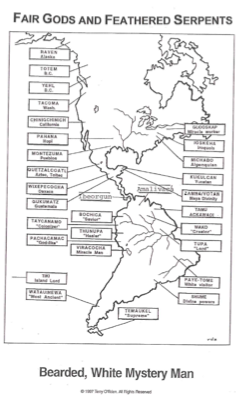2 separate Quetzalcoatls
QUETZALCOATL, TWO SEPARATE AND DISTINCT HISTORICAL BEINGS
by Ted E. Brewerton
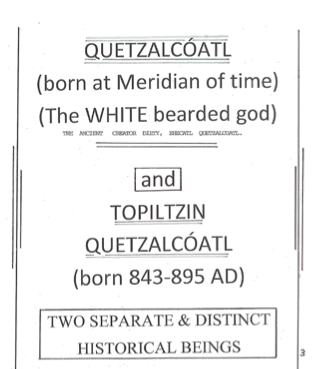
Many Latter-day Saints have heard the name Quetzalcoatl (feathered serpent), a man, bearded and white that descended out of the heavens in ancient America. He is associated with the Savior as he was born in the meridian of time. Some know that a good man born in ancient Mexico in 843 AD, adopted the name Topiltzin Quetzalcoatl and became confused with the original Quetzalcoatl. Even the Catholic friars who arrived at, or soon after the Spanish conquest of 1519, "mixed" the history of these two men.
This presentation clarifies the history of these two separate and distinct historical beings.
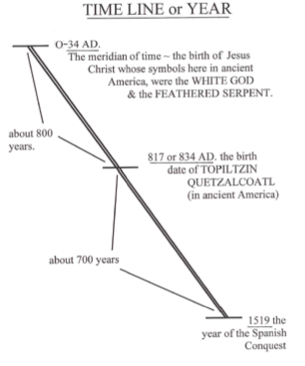
At the bottom of the time line where the date 1519 is indicated, both the indigenous writers and the Spanish Friars are referring more to Topiltzin Quetzalcoatl (born 834 AD) who lived in Tula, Mexico. Yet, they incorporated more in their writing of the qualities of the original Quetzalcoatl, born in the meridian of time. They mixed and confused the two, something that can happen when there are only primitive records and over a long period of time.
I have collected many of these ancient texts of the 1500's written in 16th century Spanish (and some in dialect)
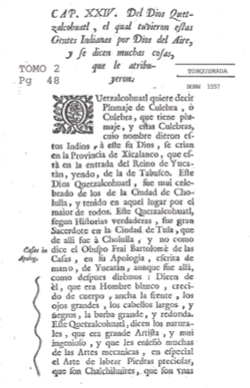
The ancient history of America tells us about a white bearded god called Quetzalcoatl or Kukulcan or other names came to this land descending from the sky as if he had wings. He then healed the people of all diseases and taught them civilized ways of living. The feathers on or about him are their symbol indicating he could fly while the serpent is the symbol of healing.
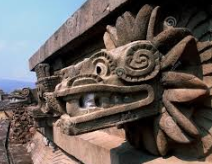
One of the embellishments on the Temple of Quetzalcoatl at Teotihuacan in Mexico
Critics claim that both the Spanish chroniclers and the indigenous peple at the same time period, are referring to Topiltzin Quetzalcoatl and not to an earlier Quetzalcoatl. The indigenous people of ancient America remembered their history, with some variations, through the myths about Quetzalcoatl, especially the coming of the White God who had descended out of the sky, teaching their people, and healing their sick and afflicted. Over the centuries, the civic and military rulers of the native people desired to elevate themselves and take on the visage of a semi-god. So they adorned themselves with the beautiful feathers of the Quetzal bird, indicating they could fly, making the feathers a prized item of trade. In addition they associated themselves with the serpent which represented healing powers. Quetzal feathers became highly desirous and expensive items of trade. Though the birds lived mostly in Guatemala, ancient records show the presence of their feathers all over Central America and into North America.
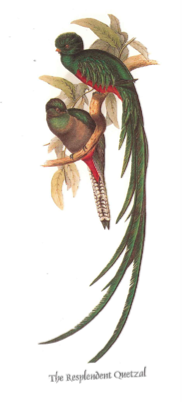
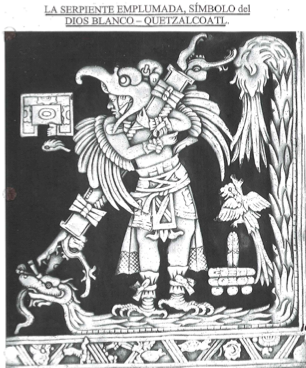
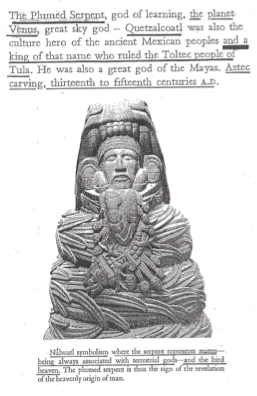
Quetzalcoatl had other names, The Plumed Serpent, God of Learnng, the planet Venus, the great Sky God and king of the Toltec people of Tula. He was the culture hero of the ancient Mexican peoples and a great god of the Maya.
The carving above is Aztec from sometime between the thirteenth to fifteenth centuries AD. It contains many elements of symbolism including the serpent (coatl) being wrapped around the figure representing a terrestrial element while on top of that that is the Quetzal bird from the heavens. The combined plumed serpent is a representation of the divine origin of man.
The purpose of this paper is to show that there are two separate and distinct historical beings even though history mixes and confuses these two men. Many leaders, in an effort to elevate themselves, wore the garb of Quetzalcoatl and attempted to convince people of their divinity. The most well known man who did this was born in 817 AD and died in 985 AD. His name was Topiltzin and he added Quetzalcoatl to his name. Over the centuries, both the local people and the Catholic fathers (after 1519) confused and mixed this man with the original white god born over 800 years earlier. The primary intent of this paper is to document that they were two separate and distinct historical people.
Elder Neal A. Maxwell has written: "It is my opinion that all the scriptures, including the Book of Mormon, will remain in the realm of faith. Science will not be able to prove or disprove holy writ. However, enough plausible evidence will come forth to prevent scoffers from having a field day, but not enough to remove the requirement of faith. (Plain and Precious Things, p.4)
Follows several quotes from scholars who researched extensively the history of this historical figure, and they distinguish between the original man who came to ancient America about the time of Christ and the man Topiltzin, a Toltec.
Most of the historians were Catholic priests or friars who came to America at the time of Hernan Cortez shortly after the Spanish conquest of 1519. They were confused and mixed the history of these two men; whatsmore many rulers or kings adopted the name of Quetzalcoatl to be like this superior being.
Father Bartlome de Las Casas (Seville, c. 1474 – Madrid, 18 July 1566), was a 16th-century Spanish historian, social reformer and Dominican friar. He was an advocate for the humane treatment of the indigenous people of the Americas, was one of the most important religious figures of the 16th-century Spanish world. As Spain struggled to develop a policy regarding the peoples of the New World, Las Casas, spent years attempting to expose the abuses that the native population was subjected to under theencomienda system. He also devoted a great deal of energy trying to convince the Spanish Crown that its mission to spread the Christian faith in the Americas did not have to deprive indigenous people of their freedom, sovereignty, and property rights. He wrote, "In the case of Quetzalcoatl it is justified to say here is a deified man, since there existed a Toltec prince named CeAcatl Topiltzin, who in time was confused with the ancient creator God Quetzalcoatl.
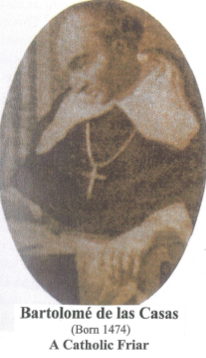
Ixtlilxochitl: Born sometime between 1568 and 1580, Alva Cortés Ixtlilxóchitl was a direct descendant of the ancient rulers of Texcoco. He was also the great-great-grandson of Cuitlahuac, the Aztec ruler of Tenochtitlan. He was a distinguished student at the Imperial College of Santa Cruz de Tlatelolco, where he was educated in both Nahuatl and Spanish. He lived in San Juan Teotihuacán from 1600 to 1604. He was commissioned by the Spanish viceroy of New Spain to write histories of the indigenous peoples of Mexico. HisRelación histórica de la nación tulteca (usually called Relación) was written between 1600 and 1608. This was an account of many events in New Spain, and many events of the Toltec people. The Relación and most of his other accounts and compilations contain writing fragments and songs, with much repetition and little organization.
In 1608, he was employed as interpreter by the viceroy, which appointment he owed to his learning and skill in explaining the hieroglyphic pictures of the ancient Mexicans. He had also a profound knowledge of the traditions of his ancestors which were preserved in the national songs, and was intimate with several old Indians famous for their knowledge of Mexican history. He turned his own labors and those of his friends to account in composing works on the history of his country. He wrote: "Quetzalcoatl, whom they consider God of the Air, according to the referred history, and by the annals (records), happened or appeared just a few years after the birth of Christ our Lord. (The original or 1st White God)."
The text, Annals of Cuautitlan, recorded in 1570, gives the account of this man. "This book is primarily an historical document with only a sprinkling of mythology."
Documents written after the Spanish Conquest in the Nahuatl language but using the Roman alphabet, contain much information about the history of the ancient American people ... the most reliable are considered to be those contained in the Annals of Cuautitlan.
Quote from the Annales di Cuautitlan:
"According to what they say, in the year I Reed (843 AD) Topiltzin Quetzalcoatl was born, his father was Totepeuh (Mixcoatl) and his mother was Chimalman, they say Quetzalcoatl was placed in his mother's belly when she swallowed a piece of Jade."
"In the year 5 House (873 AD) the Toltecs went to get Quetzalcoatl to make him their ruler in Tollan and in addition he was their priest." It is around this legendary or possibly even historical figure that the history and traditions of the post classic period revolve. "He became a priest of the god Quetzalcoatl, the feathered serpent of Teotihuacan origins" He founded a new capitol in central Mexico called Tollan, subsequently renamed Tula by the Spanish.
Alfonso Toro (born 1873): "The historian and reporter Alfonso Toro was born in Zacatecas City in 1873. He studied law in the Institute of Sciences and received his lawyer's license in 1898 as one of the best taking the examination. He was a circuit judge in various legal districts of the state. In 1932 he was placed in charge of the general archives of the Mexican Supreme Court and the National Museum. He studied history and wrote several books among which is the Compendio de historia de México (from the discovery of America to the end of the 19th century)(1926), Importancia del estudio de la historia y métodos de investigación histórica (1927), La cántiga de las piedras (re-edited in 1961). He died in 1952.
Toro wrote: "Quetzalcoatl was a royal being, an historical person, king, priest ....and they identify him with the planet Venus .... the diverse legends confuse him with different persons such as Topiltzin .... was he indigenous or did he come from the world? Some Catholic priests wish to believe he was the apostle Thomas. You will see that the hierarchy, the high priests of Mexico wore or carried the title - Quetzalcoatl - even Motecuhzoma II, they were regarded as substitutes of god.
Laurette Séjourné (October 19, 1911 – May 25, 2003) was a Mexican archeologist and ethnologist best known for her study of the civilizations of Teotihuacan and the Aztecs and her theories concerning the Mesoamerican culture hero, Quetzalcoatl. From her book The Universe of Quetzalcoatl she writes, "Teotihuacan offers the most direct relationship between the serpent-bird and the mythical king. Near his bearded face you see the hieroglyph of his name: the head of a feathered serpent placed on a straw mat, which symbolizes power. This hieroglyph can only be read as --- "The Lord Quetzalcoatl." This is the first lord Quetzalcoatl, known until now as a distant ancestor from the second to third century after Christ.
Henry Bigger Nicholson (September 5, 1925 – March 2, 2007) was a prominent scholar of the Aztecs. As with other researchers, Nicholson distinguishes between two individual historical men, Ehecatl (Diety) Quetzalcoatl and Topiltzin Quetzalcoatl. "Probably no indigenous New World personage has aroused more interest or more controversy than Topiltzin Quetzalcoatl, the Lord of tollan of the Toltec empire who was merged with the feathered serpent go Quetzalcoatl" The extant literature on this famous man/god is enormous and steadily growing. We are, however, dealing with a personage who represented a fusiono of Ehecatl Quetzalcoatl and Topiltzin Quetzalcoatl. To the people of Mexico, recollections of their great priest/ruler result in an ancestral figure that combines many aspects of this personage.
After careful consideration of the evidence, Nicholson concluded that, "Quetzalcoatl appears in two different guises --- first, under the name Ehecatl Quetzalcoatl, one of the first gods who participates actively in the creation of the earth and man, and second, much later, under a different name, as the great ruler of the Toltec, Topiltzin Quetzalcoatl. In spite of the obvious myth surrounding the renowned Toltec Priest-ruler, some of Topiltzin Quetzalcoatl's recorded life and deeds are drawn from historical fact."
Fernando Diaz Infante professor at University of Veracruz, Mexico, currently lives in Leon Guanajuato, Mexico writes the following: Quetzalcoatl is the most imposing, majestic, grandiose, disclosing and mysterious of all the belief or beings of Mesoamerica. This person had enormous importance in the formation of the culture. He was born in the year ce-acatl (about 935 AD), but as is stated in the Annals of Cuauhtitlan on page 291, he later seems to have been blended and confused with certain supernatural personalities, particularly an ancient creator, Ehecatl Quetzalcoatl.
Pierre Honoré is the author of In Quest Of The White God (published 1975) and In Search of Quetzalcoatl. The chroniclers gave the names of ten Toltec rulers, beginning in 856 AD, the fifth being the white, bearded Quetzalcoatl who reigned from 947 to 999 and, after teaching them science, morality, no human sacrifice, agricultural concepts and vegetarianism, he eventually left his people. Some legends have it that he had stayed twenty years in Cholula where a great pyramid was built in his honor, then travelled to the Yucatan near the island of Coaumel and, after speaking to the people, went out into the ocean and either disappeared of burned himself to death, either myth accepted by most.
When the Spaniards arrived in 1519, they heard only the legend of the great ancient city where a white god was once king.
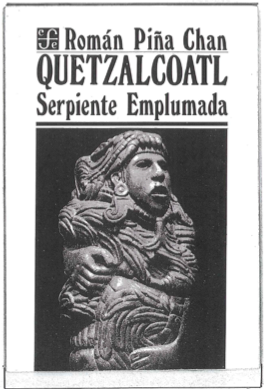
Roman Piña Chán studied in Campeche, in the Industrial School and in Mexico in National Polytechnic Institute . As Emeritus Professor, National Institute of Anthropology and History, his studies on the Hispanic cultures, primarily those of the center and the Gulf of Mexico helped to characterize the chronological stage called periodization Preclassic in his book Las Preclassic cultures of the Valley of Mexico (1955 ).
His work in enriching past history is exemplified by some 100 publications, among which are Tlatilco (1958), Quetzalcoatl, Feathered Serpent (1977), Cultures and cities of the Maya (1959), in which he assembled important research material.
He also studied at the National School of Anthropology and History by a fellowship in the specialty of physical anthropology, and later, was in charge of various works for the National Museum of Anthropology in Mexico City.
He writes: Quetzalcoatl was originally the diety of Venus (Revelations 22:16) to whom they attributed all the good and wise ... he was the archtype that gave origin to a series of priests and chiefs that over time were elevated to semigods; he was the creator and giver of life ....Quetzalcoatl was a concept, resulting from a profound sense of religious symbolism, that at the end of the classic era, synthesized a true philosophoy in an old religion that was monotheistic that spread all over Mesoamerica; and that Quetzalcoatl was not born of a real personage, but a god who, later, gave hs name to various governor-priests.
Harold Osborne in his book, South American Mythology states: In South America, the long line of Peruvian kings was compiled by the historian Montesinos, who places the beginning of these royal lines at about the dawn of christianity. Since the South American culture hero Viracocha is at the very beginning of the noble list of all Peruvian kings, that would place him around the time calculated for the first, original Quetzalcoatl in Mesoamerica - about the time of Christ.
Bernardino de Sahagún (1499 – October 23, 1590) was a Franciscan friar, missionary priest and pioneering ethnographer who participated in the Catholic evangelization of colonial New Spain (now Mexico). Born in Spain, in 1499, he journeyed to New Spain in 1529, and spent more than 50 years in the study of Aztec beliefs, culture and history. Though he dedicated himself primarily to the missionary task, his extraordinary work documenting indigenous worldview and culture has earned him the title “the first anthropologist.” He died about 60 years later, still in Mexico. He stated: "... they (the Indians) knew and had records of the things their ancestors had done and had left in their annals (historical records) more than 1000 years ago!
Sahagun claimed that the indigenous people before the arrival of the Spaniards had painted chronicles (their history) adapted from their old books available for reference. Some say pictographic codices others say symbols, etc. An interesting sidenote from Sahagun: "As to the origin of these indigenous people, the older wiser ones said they came from across the sea in seven boats, came down the coast and disembarked at Panuco (near Tampico, Mexico) in search of an earthly paradise. They had an oracle, from God -- these are our forefathers, our brothers who came from the trunk of Adam, as we do .....
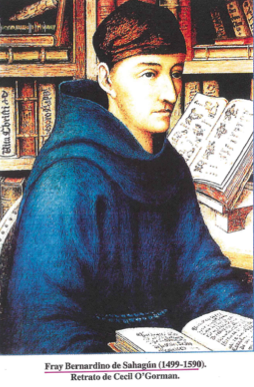
Sahagún is perhaps best known as the compiler of the Historia general de las cosas de la Nueva España (in English: General History of the Things of New Spain (hereinafter referred to as Historia General). The most famous extant manuscript of the Historia General is the Florentine Codex. It is a codex consisting of 2400 pages organized into twelve books with approximately 2,000 illustrations drawn by native artists using European techniques. The text is bilingual in Spanish and Nahuatl on opposing folios, and it documents the culture, religious cosmology(worldview), ritual practices, society, economics, and history of the Aztec people. In the process of putting together the Historia general, Bernardino pioneered new methods for gathering ethnographic information and validating its accuracy. The Historia General has been called “one of the most remarkable accounts of a non-Western culture ever composed,” and Bernardino has been called the father of American ethnography.
The first edition was printed in 1956 by Porrua in Mexico. The basic intent of Sahagun was to evangelize to Catholicism the indigenous people and rid them of their 'Christian' beliefs which he called idolatry.
Some copies found today on the internet are 'partial' and run about 200 pages. My edition purchased over 25 years ago has about 1100 pages. One might say 'nearly original source material.' It contains 12 books first published in Mexico in 1829.
